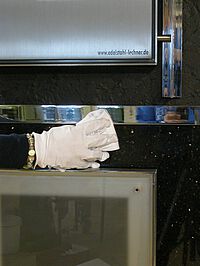surface protection from stainless steel
Nature shows us with many examples of how we have to act to make our lives easier.
How to clean surfaces from stainless steel
Care and cleaning of the surface
Also, pickling and grinding are performed for the purpose of surface cleaning. These are also work steps that become necessary in the course of production by heat treatment or welding and to eliminate any extraneous rust corrosion that may have occurred.
Care and cleaning, on the other hand, are understood to mean the cleaning of finished and in use stainless steel items for optical or hygienic reasons and for the maintenance of value.
In general, it should be noted that the hard, dense and non-porous surface of the stainless steels is insensitive and easy to clean. The material is resistant in its full cross section and does not require protective coatings that can peel off or be repelled. The excellent corrosion resistance also allows cleaning with highly active cleaning agents as they are required for disinfection and sterilization.
As a care, we recommend our in-house stainless steel care product with essential ingredients made of resin-free oil with special formula, the Lechnerpflegeöl.
Light impurities
The cleaning and care begins in the household with the removal of fingerprints, dust, water spots or food particles. For this purpose, in most cases, sufficient water with soap or household cleaning products, where to clean soft brushes or. Towels are used. When water droplets dry, stains will remain on the steel surface, depending on the hardness of the water.
If they interfere with the optical image, the affected article should be dried (dried) after rinsing or wetting. There is no objection to the use of metal preservatives which contain care components (eg hard wax) as well as cleaning-active substances and which are spread over the surface very thinly and over a large area.
Medium strong impurities
Slightly yellowed yellowing of the surface due to atmospheric dirt with occasionally firmly adhering dirt particles, whereby even a dirty gray-yellowish surface discoloration can occur, can be addressed as medium-strength impurities. In such cases, for cleaning in addition to the usual metal cleaners commercially available 10 to 20% phosphoric acid solution, which is best sprayed on and allowed to act for about 10 minutes. A support of the cleaning process by brushing, if possible in the possibly existing grinding direction, is appropriate. Finally, it should be rinsed with a lot of water and, if necessary to avoid water spots, also be sprung. When handling the acid media, safety glasses and protective gloves should be worn for safety. Temperatures below room temperature bring u. U. lower cleaning effects.
For heavy soiling
from yellowish-brown to greenish-blue appearance and starting slight foreign rust attack should be used in general commercial metal cleaners for cleaning.
These are also applied with a cloth made of linen or cotton in the direction of grinding and wiped off after a short exposure time. Also in this case, rinse with clear water as final treatment.
For particularly stubborn soiling, it is recommended to use a brush disc soaked in metal cleaner, if the starting surface allows it.

